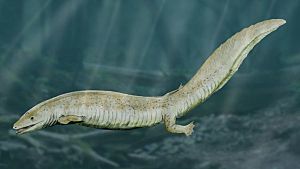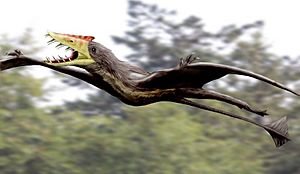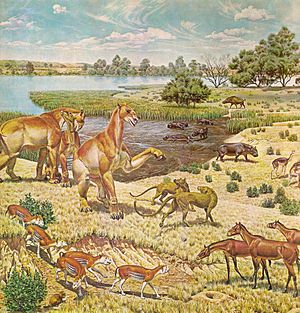Phanerozoic facts for kids
The Phanerozoic eon is the current major time period on Earth's geologic timeline. It's the eon where lots of animal life has existed. It started about 541 million years ago, when animals with hard shells first appeared. People once thought that life began in the Cambrian, which is the first period of this eon.
The time before the Phanerozoic was called the Precambrian. Now, it's divided into the Hadean, Archaean, and Proterozoic eons.
Contents
Eras of the Phanerozoic
The Phanerozoic is split into three big eras: the Paleozoic, Mesozoic, and Cenozoic. These eras are then divided into 12 smaller periods. The Paleozoic saw the rise of fish, amphibians, and reptiles. The Mesozoic was dominated by reptiles, especially dinosaurs (including birds). The Cenozoic is the time of mammals, and more recently, humans.
Paleozoic Era
The Paleozoic was a time when complex life forms first appeared. They took their first breaths on dry land, and the ancestors of all life on Earth began to spread out. There are six periods in the Paleozoic era: Cambrian, Ordovician, Silurian, Devonian, Carboniferous, and Permian.
Cambrian Period

The Cambrian is the first period of the Paleozoic Era. It started about 541 million years ago. The Cambrian saw a super-fast burst of evolution called the Cambrian Explosion. During this time, more new creatures evolved than in any other single period in Earth's history. Plants like algae grew, and the oceans were full of armored arthropods, such as trilobites. Almost all major groups of marine animals first appeared then. During this period, the supercontinent Pannotia began to break apart. Much of it later came together to form the supercontinent Gondwana.
Ordovician Period
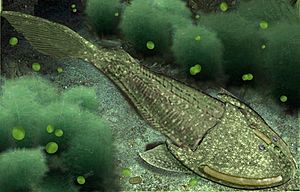
The Ordovician lasted from 485 to 444 million years ago. Many species that are still around today evolved during this time. These include early fish, cephalopods, and coral. However, the most common forms of life were trilobites, snails, and shellfish. Importantly, the first arthropods crawled onto land to explore Gondwana, which had no animal life yet.
By the end of the Ordovician, Gondwana had moved to the South Pole. This caused a major drop in sea level due to ice sheets. This led to the Ordovician-Silurian extinction. About 60% of marine invertebrates died out. This was the first mass extinction and the second deadliest in Earth's history.
Silurian Period
The Silurian lasted from 444 to 419 million years ago. During this time, Earth warmed up after the "Snowball Earth" event. This period saw a huge increase in fish types. Jawless fish became more common, jawed fish evolved, and the first freshwater fish appeared. However, arthropods like sea scorpions were still the top predators.
Life fully moved onto land, including early arachnids, fungi, and centipedes. The evolution of vascular plants (Cooksonia) allowed plants to grow on land. These early land plants are the ancestors of all plants we see today. New sea habitats also appeared, leading to many new species.
Devonian Period
The Devonian lasted from 419 to 359 million years ago. It's sometimes called the "Age of the Fish." Fish became incredibly diverse, including armored fish like Dunkleosteus. Lobe-finned fish eventually evolved into the first tetrapods (four-legged animals).
On land, different plant groups grew. The first trees and seeds evolved. By the middle Devonian, there were shrub-like forests of early plants like lycophytes, horsetails, and ferns. This also helped arthropods spread out into new land habitats. The first amphibians also evolved. Near the end of the Devonian, 70% of all species died out in the Late Devonian extinction. This was the second mass extinction.
Carboniferous Period
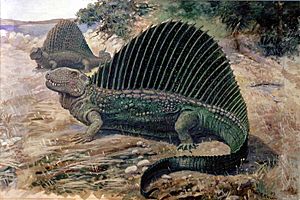
The Carboniferous lasted from 359 to 299 million years ago. During this period, global temperatures were very high. Tropical swamps covered much of Earth. The huge amounts of trees in these swamps created much of the carbon that later became coal deposits. This is why it's called the Carboniferous Period.
High oxygen levels from these swamps allowed giant arthropods to grow very large. Perhaps the most important evolution was the amniotic egg. This allowed amphibians to move further inland. The first reptiles and synapsids (ancestors of mammals) also evolved in these swamps. The Earth gradually cooled during this period. This led to ice sheets forming on Gondwana, which was near the South Pole.
Permian Period
The Permian lasted from 299 to 252 million years ago. It was the last period of the Paleozoic Era. At its start, all continents joined together to form the supercontinent Pangaea. This huge landmass was surrounded by one giant ocean called Panthalassa. Earth was very dry during this time, with harsh seasons.
Reptiles and synapsids thrived in the new dry climate. Creatures like Dimetrodon and Edaphosaurus were common. The first conifers (cone-bearing trees) evolved and spread across the land. Near the end of the period, Scutosaurus and gorgonopsids lived in the dry lands. Eventually, they disappeared along with 95% of all life on Earth. This event is known as "the Great Dying". It was the world's largest mass extinction event.
Mesozoic Era
The Mesozoic lasted from 252 to 66 million years ago. It's also known as "the Age of the dinosaurs." This era saw reptiles rise to dominate Earth for 150 million years. They lived on land, in the seas, and in the air. There are three periods in the Mesozoic: Triassic, Jurassic, and Cretaceous.
Triassic Period
The Triassic lasted from 252 to 201 million years ago. It was a time of change between the Permian Extinction and the lush Jurassic Period. It has three main parts: Early Triassic, Middle Triassic, and Late Triassic.
The Early Triassic (252 to 247 million years ago) was mostly deserts. Pangaea had not yet broken up, so its center was very dry. Earth had just gone through a huge die-off where 95% of all life became extinct. The most common animals were Lystrosaurus, labyrinthodonts, and Euparkeria. These were creatures that survived the Great Dying. Temnospondyli (a group of amphibians) were common predators.
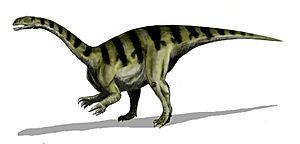
The Middle Triassic (247 to 237 million years ago) saw Pangaea begin to break apart. The Tethys Sea started to form. Life on Earth recovered from the Great Dying. Phytoplankton, coral, and crustaceans all bounced back. Reptiles started to grow larger. New aquatic reptiles, like ichthyosaurs and nothosaurs, became common in the seas. On land, pine forests grew, along with insects like mosquitoes. The first ancient crocodilians evolved, competing with large amphibians.
The Late Triassic (237 to 201 million years ago) had frequent temperature rises and moderate rain. This warming led to a boom in reptile evolution on land. The first true dinosaurs and pterosaurs (flying reptiles) evolved. By the end of the period, the first giant dinosaurs had appeared. However, the climate change led to a large die-out called the Triassic-Jurassic extinction event. Many archosaurs (except crocodiles and dinosaurs), most synapsids, and almost all large amphibians died out. About 34% of marine life also became extinct. This was the fourth mass extinction.
Jurassic Period
The Jurassic lasted from 201 to 145 million years ago. It has three main parts: Early Jurassic, Middle Jurassic, and Late Jurassic.
The Early Jurassic (201 to 174 million years ago) was much more humid than the Triassic. The world was very tropical. In the oceans, plesiosaurs, ichthyosaurs, and ammonites were common. On land, dinosaurs and other reptiles ruled. Species like Dilophosaurus were top predators. The first true crocodiles evolved, pushing large amphibians almost to extinction. The first true mammals also evolved, but they were very small, never bigger than a shrew.
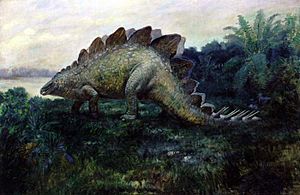
The Middle Jurassic (174 to 163 million years ago) was a time when dinosaurs thrived. Huge herds of sauropods, like Brachiosaurus and Diplodocus, filled the fern prairies. Many other predators, like Allosaurus, also appeared. Conifer forests covered much of the world. In the oceans, plesiosaurs and ichthyosaurs were common. This was the peak time for reptiles.
The Late Jurassic (163 to 145 million years ago) saw a big decline of sauropods and ichthyosaurs. This was due to Pangaea splitting into Laurasia and Gondwana. Sea levels rose, destroying fern prairies and creating shallow seas. Ichthyosaurs became extinct. Some sauropods, like Titanosaurus, lived until the K-T extinction. The rising sea levels opened up the Atlantic sea way, which continued to grow. The divided world allowed new types of dinosaurs to evolve.
Cretaceous Period
The Cretaceous is the longest period in the Mesozoic. It lasted from 145 to 66 million years ago. It's divided into two parts: Early Cretaceous and Late Cretaceous.
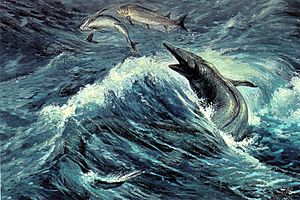
The Early Cretaceous (145 to 100 million years ago) saw the oceans expand. This led to the decline and extinction of most sauropods (except in South America). Many shallow coastal areas formed, causing ichthyosaurs to die out. Mosasaurs evolved to become the new top predators of the seas. Some dinosaurs, like Eustreptospondylus, adapted to living on small islands. Other dinosaurs, like Carcharodontosaurus and Spinosaurus, filled the empty spaces left by the Jurassic-Cretaceous extinction. Iguanodon became very successful and spread to every continent. Seasons became more noticeable, and the poles grew colder. Dinosaurs like Leaellynasaura lived in polar forests year-round. Pterosaurs reached their largest sizes, with species like Tapejara and Ornithocheirus flying in the skies. The first true birds also evolved.
The Late Cretaceous (100 to 66 million years ago) saw a cooling trend that continued into the Cenozoic Era. Tropical areas became smaller, and places beyond the tropics had extreme seasonal weather. Dinosaurs still thrived. New species like Tyrannosaurus, Ankylosaurus, Triceratops, and Hadrosaurs dominated the food web. Giant pterosaurs like Quetzalcoatlus also lived. Marsupials (like kangaroos and opossums) evolved in the conifer forests. In the oceans, Mosasaurs ruled, and huge plesiosaurs like Elasmosaurus evolved. The first flowering plants also appeared.
At the end of the Cretaceous, volcanic eruptions were poisoning the air. It's also thought that a large meteor hit Earth, creating the Chicxulub Crater. This caused the K-T Extinction, the fifth and most recent mass extinction. About 75% of life on Earth died out, including all non-bird dinosaurs. Every living thing over 10 kilograms became extinct, and the age of the dinosaurs ended.
Cenozoic Era
The Cenozoic saw mammals become the main type of animals. The end of the dinosaur age left many empty spaces for new species to evolve. There are three main parts of the Cenozoic: Paleogene, Neogene, and Quaternary.
Paleogene Period
The Paleogene lasted from the extinction of the non-bird dinosaurs (66 million years ago) to 23 million years ago. It has three epochs: Paleocene, Eocene, and Oligocene.

The Paleocene Epoch began with the K-T extinction event. This was caused by a meteorite impact and wiped out 75% of all species. The Early Paleocene saw Earth recover. The continents started to look like they do today, but they were all separated. The world generally warmed, and jungles even reached the poles. Sharks ruled the oceans. Early mammals, like creodonts and early primates, filled the world. Mammals were still quite small. Huge crocodiles and snakes like Titanoboa became top predators.
The Eocene Epoch lasted from 56 to 34 million years ago. In the early Eocene, most land mammals were small and lived in dense jungles. These included early primates, whales, and horses. Giant birds, like Gastornis, were at the top of the food chains. The temperature was warm everywhere, even at the poles. In the Middle Eocene, ocean currents changed, causing global cooling. Jungles shrank, allowing mammals to grow larger. Whales became almost fully aquatic and grew to huge sizes. Mammals like Andrewsarchus became top predators on land. Sharks were replaced by whales like Basilosaurus as rulers of the seas. The late Eocene saw seasons return, and grasslands began to spread.
The Oligocene Epoch lasted from 34 to 23 million years ago. This was an important time of change from a tropical world to more modern ecosystems. Grasslands spread globally, leading to many new species. These included the first elephants, cats, dogs, and marsupials. Many other plants, like evergreen trees, also evolved. The cooling trend continued, and seasonal rain patterns became normal. Mammals continued to grow larger. Paraceratherium, the largest land mammal ever, evolved during this time.
Neogene Period
The Neogene lasted from 23.03 to 2.58 million years ago. It has two epochs: the Miocene and the Pliocene.
The Miocene lasted from 23.03 to 5.333 million years ago. During this period, grass spread even further, covering much of the world and reducing forests. Kelp forests evolved in the oceans, leading to new species like sea otters. Perissodactyla (like horses and rhinos) thrived and evolved into many different types. Apes also evolved into about 30 species. Dry, mountainous land was common, as were grazing animals. The Tethys Sea finally closed, creating the Black, Red, Mediterranean, and Caspian Seas. This made the climate even drier. Many new plants evolved, and 95% of modern seed plants appeared in the mid-Miocene.
The Pliocene lasted from 5.333 to 2.58 million years ago. The Pliocene had big climate changes that led to modern species and plants. The Mediterranean Sea even dried up for thousands of years. During this time, Australopithecus evolved in Africa, starting the human family tree. The Isthmus of Panama formed, connecting North and South America. Animals migrated between the continents, changing local ecosystems. Climate changes brought savannas, Indian monsoons, and the beginnings of the Sahara desert. Earth's continents and seas moved into their current shapes. The world map hasn't changed much since, except for changes caused by the ice ages of the Quaternary.
Quaternary Period
The Quaternary lasts from 2.58 million years ago to today. It's the shortest Phanerozoic Eon period. It features modern animals and big climate changes. It's divided into two epochs: the Pleistocene and the Holocene.
The Pleistocene lasted from 2.58 million to 11,700 years ago. This epoch was marked by ice ages. Ice caps spread as far south as 40 degrees North latitude in mountains. Meanwhile, Africa became drier, creating the Sahara, Namib, and Kalahari deserts. Many animals evolved, including mammoths, giant ground sloths, dire wolves, saber-toothed cats, and Homo sapiens. About 100,000 years ago, a severe drought in Africa ended, leading to the spread of early humans. As the Pleistocene ended, a major extinction wiped out many of the world's large animals (megafauna), including some human species like Neanderthals. All continents were affected, but Africa less so. Africa still has many large animals, like hippos. Scientists still discuss how much humans were involved in this extinction.
The Holocene began 11,700 years ago and continues to today. All recorded human history happened during the Holocene epoch. Human activity is blamed for a mass extinction that started about 10,000 years ago. However, species extinctions have only been recorded since the Industrial Revolution. This is sometimes called the "Sixth Extinction." More than 322 species have become extinct due to human activity since the Industrial Revolution.
Images for kids
-
Dalmanites limulurus, a type of Silurian trilobite.
-
Dimetrodon grandis, a synapsid from the early Permian.
-
Stegosaurus, a large dinosaur from the Late Jurassic.
-
Tylosaurus, a type of large marine lizard.
-
Basilosaurus was an early whale ancestor.
-
Large animals of the Pleistocene, including mammoths, cave lions, woolly rhinos, reindeer, and horses.
See also
 In Spanish: Eón fanerozoico para niños
In Spanish: Eón fanerozoico para niños


